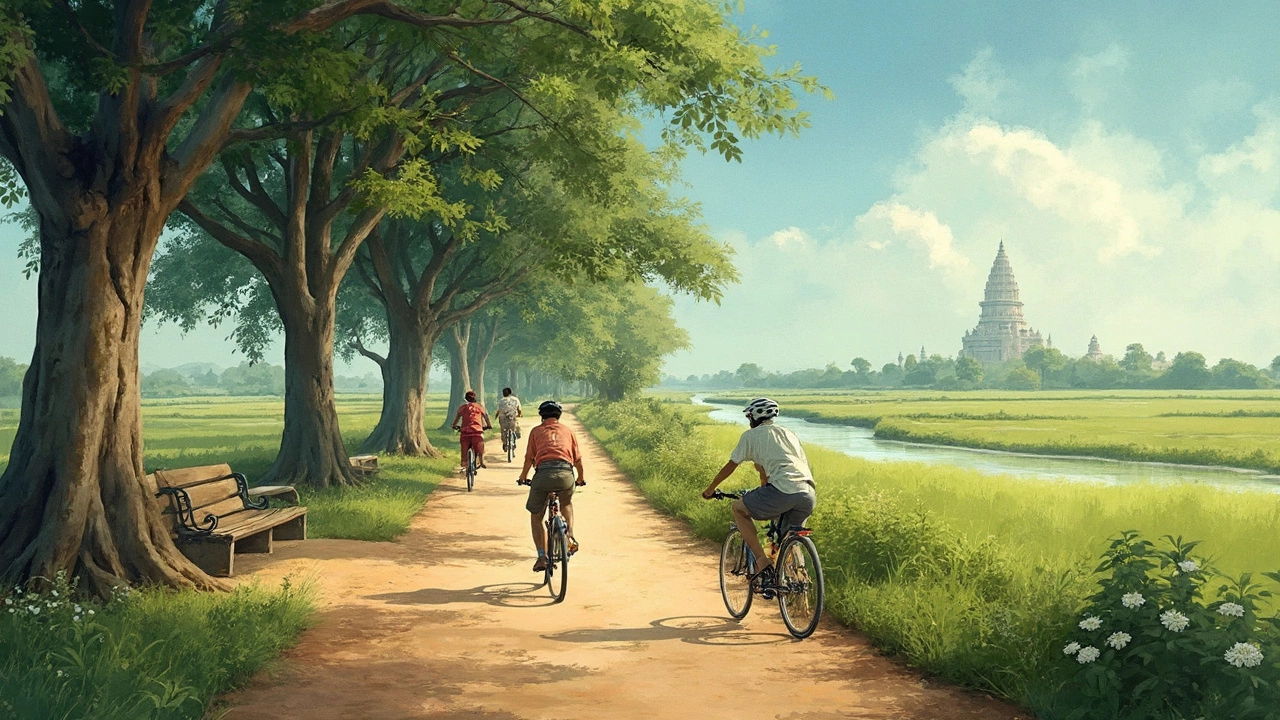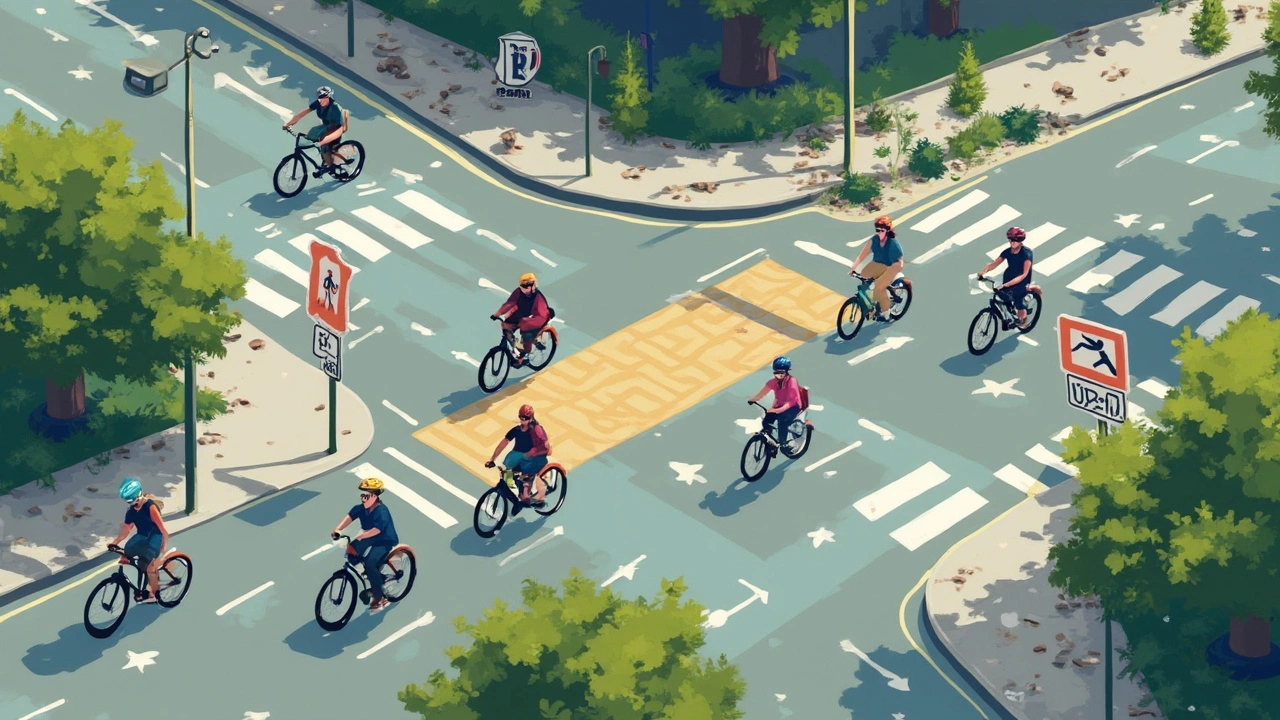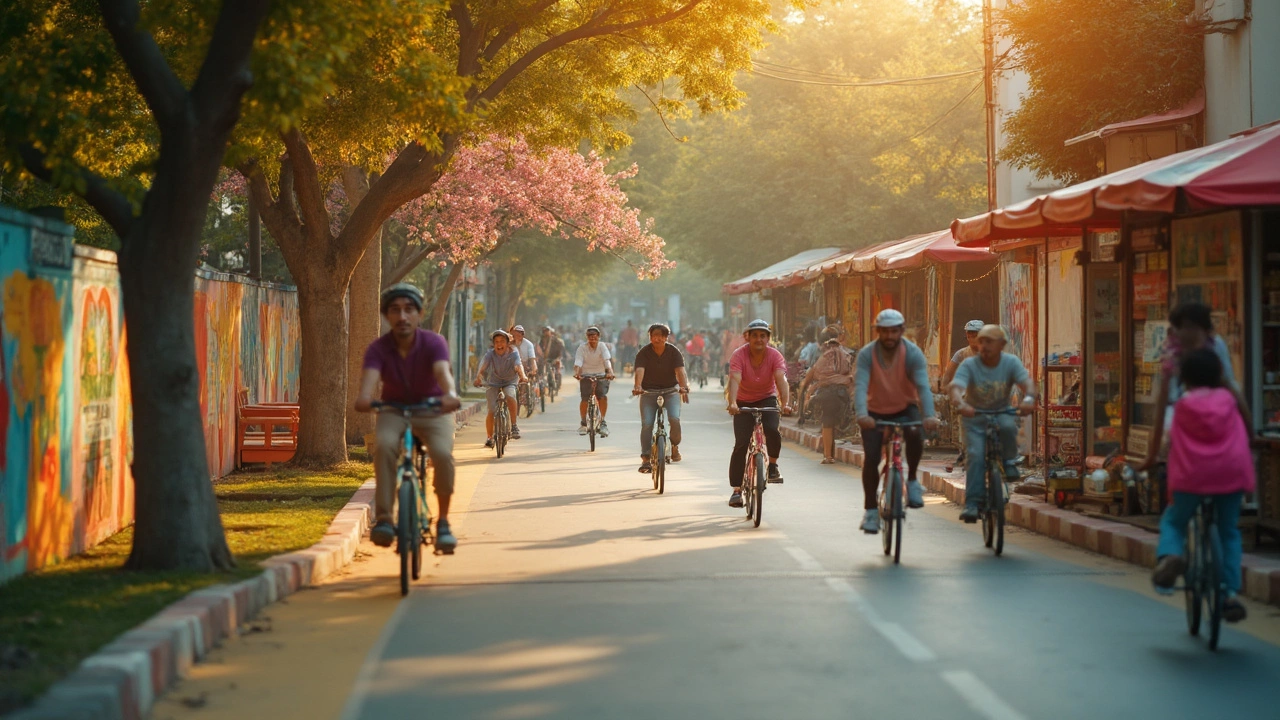Ever found yourself swerving around potholes or dodging cars on a so-called cycling path? Not fun. When you’re picking a cycling route, a lot more goes into it than just distance. Safety should be at the top of your list. Smooth pavement, clear markings, and low traffic make a huge difference. A good cycling path keeps you away from fast cars and gives you room to move. If it’s lit at night, even better.
But hey, it’s not all about dodging danger. A route with great scenery—think riversides, parks, or quiet tree-lined roads—keeps your mind in a good place and makes the miles fly by. When you enjoy the ride, you’ll want to get out more often. Sometimes the best paths aren’t the shortest—they’re the most enjoyable ones.
- Safety First: Traffic, Surfaces, and Visibility
- Scenic Appeal: Why Surroundings Matter
- Convenience: Access, Rest Stops, and Facilities
- Flow and Design: Hills, Turns, and Layout
- Popular Picks: Real Examples and Pro Tips
Safety First: Traffic, Surfaces, and Visibility
If there’s one thing that can make or break a cycling route, it’s how safe you feel while riding. Let’s break it down. Cars flying by at 60 km/h on a narrow shoulder? That’s a hard pass for most people. You want routes with low-speed traffic or, even better, dedicated lanes separated from vehicles. A lot of big cities are adding separated bike lanes and protected paths, and it’s not just about comfort—studies show this cuts cycling injuries in half.
The next thing to check is the road surface. Big cracks, loose gravel, or potholes aren’t just annoying—they’re straight-up dangerous. Smooth pavement or well-packed gravel for off-road trails helps you keep traction and avoid nasty surprises. In countries like the Netherlands, you’ll find cycle paths kept glass-smooth because cyclists are taken seriously there.
Visibility is also huge. If drivers can’t see you, or if you can’t see far ahead, your day can go south fast. Well-marked crossings, clear sightlines at intersections, and plenty of lighting when it gets dark can stop accidents before they happen. Cities improving street lighting at bike path intersections have seen fewer nighttime crashes by almost 25%.
- Look for routes with bright, reflective signs and painted lanes.
- Check for spotty lighting—especially if you ride at sunrise or sunset.
- If a path runs near traffic, barriers or even a row of parked cars can help protect you.
Bottom line: a safe bike path lets you focus on enjoying your ride, not looking over your shoulder every few seconds. Those details mean fewer close calls—and a much better time on two wheels.
| Safety Feature | Impact |
|---|---|
| Protected Lanes | Up to 50% fewer injuries |
| Smooth Pavement | Reduces falls and mechanical issues |
| Good Lighting | 25% fewer night-time crashes |
Scenic Appeal: Why Surroundings Matter
Let’s be honest, nobody really enjoys riding next to a noisy highway or staring at the same row of bland buildings for miles. What takes a cycling route from average to unforgettable is the vibe of the surroundings. The right scenery can turn even a tough ride into something you look forward to repeating. Studies from the University of Minnesota show riders are 35% more likely to repeat routes that pass by parks, lakes, or forests compared to city streets with heavy traffic.
Parks, rivers, and even local neighborhoods with plenty of greenery make your ride more relaxed and interesting. City planners in Copenhagen created miles of bike lanes that wind through botanical gardens and waterfronts, which is a big reason that over 60% of the city’s residents bike to work or school. You don’t need to ride in Denmark to get these perks. In most cities, routes following rivers or cutting through public parks often feel safer too, since they’re separated from car traffic.
If you’re looking to map out a new bike ride, check if the route:
- Runs near water—lakes, rivers, or canals usually mean flat ground and better views.
- Passes through parks or green spaces—not just for the trees, but for cleaner air.
- Keeps you away from noisy areas, industrial zones, or spots with constant road work.
- Offers some surprises: murals, cafes, or playgrounds along the way make for memorable stops.
Here’s a quick comparison of how riders rate different surroundings based on a survey by RideWithGPS:
| Route Surroundings | Average Enjoyment Score (1-10) |
|---|---|
| Urban (main streets, traffic) | 4.3 |
| Parks/Greenways | 8.7 |
| Waterfront Paths | 9.1 |
| Suburban neighborhoods | 6.0 |
When you pick a route that actually looks and feels good, you’ll ride farther, faster, and most importantly, more often. That’s a win no matter your riding style.

Convenience: Access, Rest Stops, and Facilities
If a cycling route is a hassle to reach, most folks skip it. Easy access from your home or a nearby parking area is a real game changer. Urban planners say the best bike paths often connect with public transport, making it simple to roll in and out without needing a car. In Copenhagen, for example, nearly 49% of locals use bikes daily partly because the routes link up with bus and train stations smoothly.
Riding long stretches with nowhere to stop can get pretty uncomfortable. Good cycling routes should have rest stops with basics like benches, water fountains, and some sort of shelter from rain or blazing sun. Out on popular U.S. trails like Ohio’s Little Miami Scenic Trail, you’ll run into pit stops every few miles—restrooms, picnic tables, and even quick bike repair stations.
It really helps when a route offers:
- Regular access to clean toilets and drinking water
- Bike racks or lock-up spots so you can grab a snack or snap a photo
- Shady areas and kiosks with snacks or basic supplies
- Signage showing distances, maps, and emergency info
Here’s a quick look at how some well-known U.S. cycling trails stack up:
| Route | Restroom Access | Water Stations | Bike Repair Stops |
|---|---|---|---|
| Minuteman Bikeway (MA) | Frequent | Frequent | Yes |
| Silver Comet Trail (GA) | Moderate | Moderate | Some |
| Chicago Lakefront Trail (IL) | Frequent | Frequent | Yes |
The difference these details make is huge. Reliable facilities turn a basic path into one that feels welcoming and rider-friendly for everyone—from hardcore cyclists to families with kids. And let’s face it, if you know you can take a break and refill your bottle, you’re just more likely to keep pedaling.
Flow and Design: Hills, Turns, and Layout
Let’s talk real world: a cycling route is only as enjoyable as its layout lets it be. Too many steep hills in a row? That’s a workout, not a ride. A path with constant sharp turns? It gets tiring, not fun. The sweet spot is a route with a mix—gentle climbs that get your legs spinning, smooth descents that let you coast, and decent stretches where you can find your rhythm. This is exactly why many popular bike events pick routes with a max grade between 4% and 6%—steep enough for challenge, but not soul-crushing.
Turns also play a huge role. Tight corners force you to slow down and watch out for others, while wider, gradual turns help you keep speed safely. Paths designed with clear sightlines—where you can see ahead for turns or sudden changes—cut down on accidents and those “whoa!” moments.
Here’s what smart route design usually looks like:
- Consistent surface—smooth and wide enough for passing.
- Good drainage—so puddles don’t turn parts into mini-lakes when it rains.
- Gentle grades—especially if it’s for all riders, not just hardcore cyclists.
- Predictable turns—you want to see what’s coming, not guess.
- Pacing—occasional challenging sections balanced with easy coasting.
Ever wondered why old converted rail trails are so popular? It’s the design: trains can’t climb steep hills or handle wild curves, so their old routes are naturally long, smooth, and gentle. Perfect for cyclists of all abilities.
You can actually see the difference in routes designed for cars versus those planned for cyclists. Routes built just for bikes—think the Dutch bicycle highways—often cut straight through, skip unnecessary hills, and avoid busy intersections.
If you’re planning your own route, check online elevation maps. Apps like Strava or RideWithGPS lay out elevation profiles, so you’re not caught off guard by surprise climbs. Checking this info before you pedal out saves a lot of huffing and puffing.
| Route Design Feature | Impact on Cycling Experience |
|---|---|
| Gentle Hills | Keeps the ride accessible and enjoyable for everyone |
| Wide Turns with Sightlines | Improves safety, lets you keep a steady flow |
| Consistent Surfaces | Reduces risk of accidents, boosts comfort |
| Good Drainage | Prevents big puddles, less slipping in wet weather |
So next time you’re scouting a bike path, pay attention to those hills, turns, and how the whole thing is laid out. It’s the secret behind every ride you want to do again.

Popular Picks: Real Examples and Pro Tips
Some cycling routes get talked about for a reason—they just plain work. Take the Manhattan Waterfront Greenway in New York. It stretches 32 miles and hugs the river, giving you a protected path, zero cars, and a view that’s actually worth stopping for. Thousands of city riders use it every day because it’s smooth, flat, and separate from traffic. There are signs everywhere, so you barely have to check your phone for directions.
Jump over to Europe and the Netherlands’ Vrienden van de Fiets network pops up. The routes go through open fields, little towns, and always have bike-friendly stops—cafes, repair shops, and restrooms. What's cool about Dutch bike paths is their design: dedicated lanes, smooth surfaces, and no random parked cars blocking your way. Around 27% of all Dutch trips happen by bike, and these smart routes are a big reason why.
In Australia, the M7 Cycleway in Sydney is a top pick for anyone who wants space and smooth tarmac. It’s about 25 miles end-to-end and built for all kinds of riders—from commuters to roadies. There are water fountains, shaded breaks, and only a few street crossings. That kind of convenience keeps you riding longer.
Spotting a good cycling route for yourself? Check for these things:
- Separate bike lanes or paths—ideally physically divided from traffic
- Clearly marked crossings and signs
- Places to stop for a drink, snack, or bathroom break
- Nice views—parks, rivers, safe parks
- Pavement with minimal cracks or potholes—the less dodging, the better
Apps like Komoot and Strava let you scout popular bike-friendly routes before you even clip in. Look for routes that other cyclists have rated high for safety and scenery. If you want company, some cities even post group ride schedules online—always a good way to find hidden gems.
| Route | Distance (mi) | Main Perks |
|---|---|---|
| Manhattan Waterfront Greenway | 32 | Protected lanes, river views, urban access |
| Netherlands Vrienden van de Fiets | Varies | Dedicated lanes, services, scenic countryside |
| Sydney M7 Cycleway | 25 | Long distance, rest stops, smooth surface |
One last tip—always check if your area has a local cycling safety map or website. These are packed with updates about construction, detours, or recent rider reviews. The extra info can save you a headache and help you make the most of your ride.
